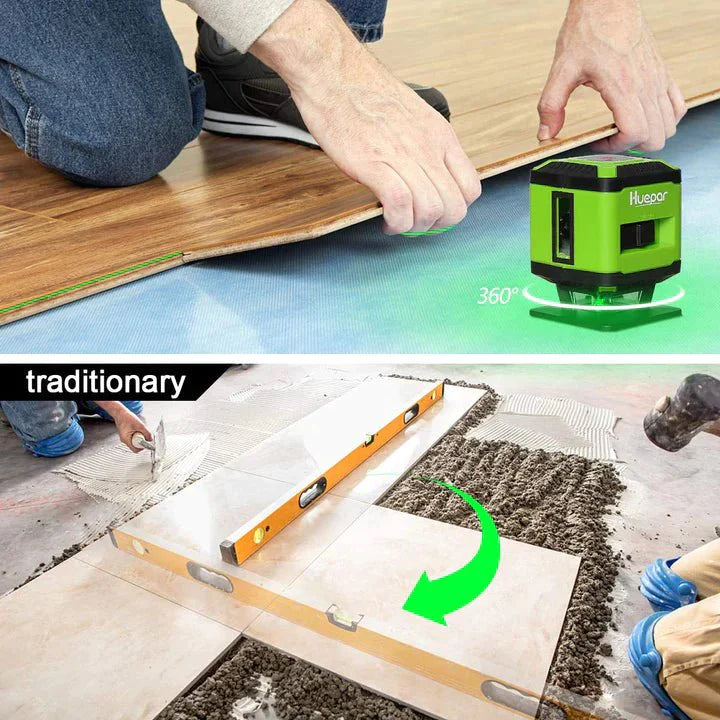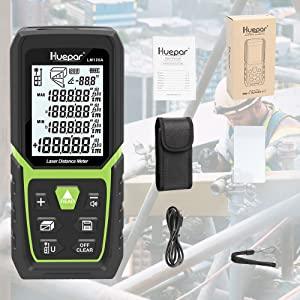Understanding Laser Levels: Basics and Types
What Are Laser Levels?
Laser levels are tools used in construction and DIY projects to create precise lines. These lines guide builders when they need to level, align, or square. The tool projects a bright laser beam onto surfaces. This shows where a straight line is needed. They can be set up on a tripod or fixed to a surface. Laser levels replace traditional tools like the bubble level and plumb bob.

The Different Types of Laser Levels
Laser levels come in various forms, each suited to particular tasks. The main types include:
- Dot Lasers: They project simple dots on a surface. Ideal for transferring points.
- Line Lasers: Emit single or multiple lines. Great for aligning work like tiling.
- Rotary Lasers: Produce a 360-degree line. Used for large outdoor areas.
- Cross Line Lasers: Cross lines for both horizontal and vertical leveling.
- 3D Laser Levels: Project lines on all three planes. Perfect for complete room layout.
- 4D Laser Levels: Similar to 3D but with enhanced features, like connecting to smart devices.
Comparing 3D, Cross Line, and 4D Laser Levels
3D, Cross Line, and 4D laser levels each serve distinct roles. 3d laser levels project lines on all walls at once. They are great for full room layout. Cross Line lasers show lines on one-two walls at a time. They are used for basic tasks like hanging pictures. 4D laser levels offer more lines. They can project lines over 360 degrees. They are best for complex projects. All three types make work faster and more precise. Choose based on your project needs.
The Advantages of Using 3D Laser Levels in Projects
Improving Accuracy and Efficiency
Using 3d laser levels can greatly improve the precision of your work. They allow for exact measurements, cutting down on errors. Their advanced technology helps with faster project completion.
- Reduce Mistakes: By providing precise lines, 3D laser levels lower the chances of errors during construction or DIY projects.
- Save Time: With clear and accurate lines projected onto surfaces, you can complete tasks more quickly without the need to remeasure.
- Improve Productivity: Construction workers and DIY enthusiasts can work more efficiently, thanks to the high precision offered by 3D laser levels.
In summary, 3d laser levels are key tools for anyone looking to enhance the accuracy and pace of their work, whether in construction or personal projects.
Versatility in Construction and DIY Tasks
3d laser levels bring a remarkable flexibility to both construction and home DIY projects. With their ability to project lines in three dimensions, they serve a wide range of applications:
- Leveling floors and ceilings: 3D laser levels offer a clear guide for creating level surfaces. This is essential in laying tiles or installing drop ceilings.
- Aligning and plumbing walls: Whether you're framing a wall or installing cabinetry, these tools ensure everything is perfectly vertical or horizontal.
- Setting slopes for drainage: In outdoor projects or plumbing, setting the correct slope is crucial. A 3D laser level makes this task easier.
- Installation of windows and doors: Precisely align and level frames to ensure proper opening and closing.
Their versatility extends beyond traditional building tasks, to landscaping, installing complex lighting systems, and even artistic projects needing precise alignment.
Safety and Ease of Use
3d laser levels boast enhanced safety features due to their design. They limit the need for manual measurement, which can reduce the risk of accidents on site. With one-button operation, users can project accurate lines in multiple dimensions without the risk of errors from manual tools. In addition, these levels typically have a locking mechanism for the pendulum, safeguarding internal components during transport. When working in bright conditions or over long distances, laser enhancement glasses and target cards can help improve visibility without strain. For DIY enthusiasts, 3D laser levels offer ease of use which can lead to safer project handling and higher confidence in tackling complex tasks. Turning mixed materials into consistent outputs becomes less daunting with such a tool, promoting a safe and enjoyable working experience.
Choosing and Using 3D Laser Levels Effectively
Factors to Consider When Selecting a 3D Laser Level
Selecting the right 3D laser level is key to project success. Here are factors to weigh:
- Accuracy: Ensure the device offers pinpoint precision.
- Range: Check how far the laser reaches. Longer is often better.
- Durability: Pick a tough tool that withstands work conditions.
- Battery Life: Longer battery life means less downtime.
- Features: Consider if you need extras like Bluetooth or a tripod.
- Price: Balance cost with the quality and features you require.
Consider these points to find the best tool for your needs.
Best Practices for Setting Up and Using Your Laser Level
To get the best results from your 3D laser level, follow these best practices for setup and usage:
- Check Calibration: Before starting your project, ensure the laser level is properly calibrated for accurate readings.
- Stable Setup: Place the laser level on a firm, stable surface or use a tripod to prevent movement and vibrations.
- Optimal Height: Adjust the height of the laser level so that the beams project at the desired level around the work area.
- Clear Line of Sight: Remove any obstacles that could block the laser beams for an uninterrupted 360-degree projection.
- Protective Gear: Wear protective eyewear when operating the laser level to safeguard your eyes from laser exposure.
- Proper Angle: Position the laser level at the correct angle to ensure that the lines are straight and precise.
- Check Alignment: Regularly verify the alignment of the laser lines with the project for continuous accuracy.
- Battery Life: Keep an eye on the battery indicator and have spare batteries to avoid interruptions during work.
Following these steps will help to ensure accurate and consistent results, making your task easier and more efficient.
Maintenance and Care for Longevity
Proper maintenance ensures your 3D laser level works well for a long time. Here's what to do:
- Clean the device after each use with a soft cloth to keep it free from dust and debris.
- Store it in a protective case to avoid damage from drops or impacts.
- Check the calibration regularly and recalibrate if necessary to ensure accuracy.
- Avoid exposing the laser level to extreme temperatures or moisture.
- Replace batteries or charge the device as recommended by the manufacturer.
By following these steps, your laser level remains reliable for every project.




